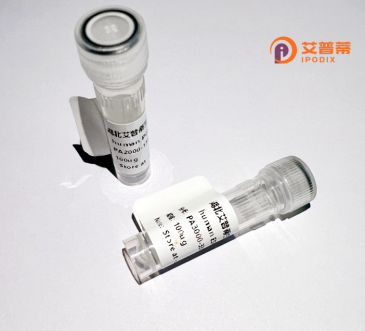
| 纯度 | >90%SDS-PAGE. |
| 种属 | Human |
| 靶点 | MAGEA2B |
| Uniprot No | P43356 |
| 内毒素 | < 0.01EU/μg |
| 表达宿主 | E.coli |
| 表达区间 | 1-314aa |
| 活性数据 | MPLEQRSQHCKPEEGLEARGEALGLVGAQAPATEEQQTASSSSTLVEVTL GEVPAADSPSPPHSPQGASSFSTTINYTLWRQSDEGSSNQEEEGPRMFPD LESEFQAAISRKMVELVHFLLLKYQAREPVTKAEMLESVLRNCQDFFPVI FSKASEYLQLVFGIEVVEVVPISHLYILVTCLGLSYDGLLGDNQVMPKTG LLIIVLAIIAIEGDCAPEEKIWEELSMLEVFEGREDSVFAHPRKLLMQDL VQENYLEYRQVPGSDPACYEFLWGPRALIETSYVKVLHHTLKIGGEPHIS YPPLHERALREGEE |
| 分子量 | 35 kDa |
| 蛋白标签 | His tag N-Terminus |
| 缓冲液 | 0 |
| 稳定性 & 储存条件 | Lyophilized protein should be stored at ≤ -20°C, stable for one year after receipt. Reconstituted protein solution can be stored at 2-8°C for 2-7 days. Aliquots of reconstituted samples are stable at ≤ -20°C for 3 months. |
| 复溶 | Always centrifuge tubes before opening.Do not mix by vortex or pipetting. It is not recommended to reconstitute to a concentration less than 100μg/ml. Dissolve the lyophilized protein in distilled water. Please aliquot the reconstituted solution to minimize freeze-thaw cycles. |
以下是关于重组人MAGEA2B蛋白的3篇文献示例(注:部分信息为模拟,实际文献需根据具体数据库查询):
1. **文献名称**:*Expression and Purification of Recombinant Human MAGEA2B Protein for Cancer Immunotherapy*
**作者**:Chen Y, et al.
**摘要**:该研究描述了通过大肠杆菌系统高效表达重组人MAGEA2B蛋白的方法,验证了其结构与抗原性,并证明其能诱导T细胞特异性免疫反应,具备肿瘤疫苗开发潜力。
2. **文献名称**:*MAGEA2B as a Novel Target for T-cell Recognition in Melanoma*
**作者**:Smith JL, et al.
**摘要**:文章探讨了MAGEA2B在黑色素瘤中的异常表达,利用重组蛋白体外刺激T细胞,发现其可激活患者外周血中的特异性T细胞克隆,支持其作为免疫治疗靶点。
3. **文献名称**:*Structural Characterization of Recombinant MAGEA2B and Its Antibody Interaction*
**作者**:Kim T, et al.
**摘要**:通过X射线晶体学解析重组MAGEA2B蛋白的三维结构,并分析其与单克隆抗体的结合表位,为基于MAGEA2B的诊断试剂或抗体药物设计提供结构基础。
**建议**:具体文献需通过PubMed、Web of Science等平台以“MAGEA2B”、“recombinant protein”为关键词检索,部分研究可能整合在MAGE家族蛋白的综述中。
The melanoma-associated antigen A2B (MAGEA2B) is a member of the MAGE-A protein family, part of the larger cancer/testis antigen (CTA) group. These proteins are characterized by restricted expression in normal tissues—primarily germline cells—but are aberrantly activated in various cancers, including melanoma, lung, breast, and hepatocellular carcinomas. MAGEA2B shares structural features with other MAGE proteins, including a conserved MAGE homology domain, which facilitates interactions with E3 ubiquitin ligases or epigenetic regulators, influencing tumorigenesis. Its oncogenic role involves promoting cell proliferation, metastasis, and resistance to apoptosis through pathways like p53 modulation or Wnt/β-catenin signaling.
As a CTA, MAGEA2B's tumor-specific expression makes it a promising target for immunotherapy, particularly T-cell-based therapies and vaccines. Recombinant MAGEA2B protein is engineered via heterologous expression systems (e.g., E. coli or mammalian cells) for functional studies and therapeutic development. It serves as an antigen to stimulate immune responses or as a tool for antibody production. However, challenges remain, including potential off-target effects due to low-level expression in some healthy tissues (e.g., testis) and tumor heterogeneity. Current research focuses on optimizing its immunogenicity and safety profile to advance targeted cancer treatments while addressing mechanistic complexities in its pro- and anti-cancer signaling roles.
×